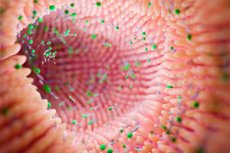New publications
Intestinal microflora may deter excessive alcohol consumption
Last reviewed: 02.07.2025

All iLive content is medically reviewed or fact checked to ensure as much factual accuracy as possible.
We have strict sourcing guidelines and only link to reputable media sites, academic research institutions and, whenever possible, medically peer reviewed studies. Note that the numbers in parentheses ([1], [2], etc.) are clickable links to these studies.
If you feel that any of our content is inaccurate, out-of-date, or otherwise questionable, please select it and press Ctrl + Enter.

Excessive alcohol consumption significantly increases the risk of developing alcohol dependence. In a study published in the journal Microbiome, a team of researchers from the University of Connecticut School of Medicine found that valeric acid, a substance produced by gut bacteria, reduced the amount of alcohol consumed in mice. These findings open up new possibilities in the search for treatments for alcohol dependence.
Binge drinking is characterized by drinking large amounts of alcohol in a short period of time, typically resulting in a blood alcohol concentration of 0.08% or higher. According to the National Institute on Alcohol Abuse and Alcoholism, four or five drinks within two hours can result in this level of alcohol in the blood. Research shows that one in three young Europeans and North Americans regularly engage in binge drinking, which increases the risk of developing alcohol dependence and other neuropsychiatric disorders in the future.
Despite the prevalence and serious consequences of alcohol abuse, effective pharmacological treatments are limited. There are currently only three medications approved by the FDA to treat alcohol dependence, and they are ineffective for most people.
Yanjiao Zhou, a microbiome scientist at the University of Connecticut School of Medicine, was intrigued by data showing that people who drink alcohol heavily often have different patterns of microbes in their guts compared to those who do not drink heavily. These gut microbes, known as the gut microbiome, also produce a different set of short-chain fatty acids (SCFAs). SCFAs are produced by the gut microbiome through the fermentation of undigested dietary fiber and protein. It has been hypothesized that the mix of SCFAs produced by gut microbes may influence patterns of alcohol consumption.
To examine the potential link between SCFAs and excessive alcohol consumption, Zhou and her colleagues used a four-day "drinking in the dark" model in mice, which mimics excessive alcohol consumption in humans. The mice were given different types of SCFAs in their food for 10 days.
The mice were then allowed to drink alcohol (20% ethanol mixed with water, no cocktails) at night for four nights. The mice fed valeric acid, but not other types of SCFAs, drank 40% less alcohol and had blood alcohol levels that were 53% lower than the other mice. These mice also showed reduced anxiety behavior.
"The finding that valeric acid reduces alcohol consumption is unexpected," says Suresh Bokolia, a postdoc in Zhou's lab. "The concentration of valeric acid in the gut is lower compared to other common SCFAs, such as butyrate and acetate."
When the team looked more closely at how valeric acid reduced alcohol consumption, they found that mice given valeric acid supplements had increased levels of GABA, a chemical known for its calming effects, in the amygdala, a region of the brain associated with mood and addictive behavior. They also found that genes involved in energy production and anti-inflammatory activity were more active, while genes associated with depression were less active.
"There are likely multiple mechanisms involved to explain how valeric acid reduces alcohol consumption," Zhou says. "But the effects of this microbial metabolite on brain epigenetics may be quite powerful in regulating alcohol-use behavior."
Zhou’s lab collaborated closely with John Kowalt of the University of Connecticut’s Center for Alcohol Research, Jason Bubier of the Jackson Laboratory, and Jessica Barson of Drexel University. The researchers are now testing the approach in other mouse models that more closely mimic alcohol addiction to see if valeric acid can effectively treat alcohol addiction in people.
